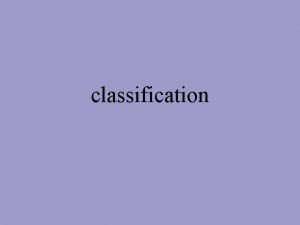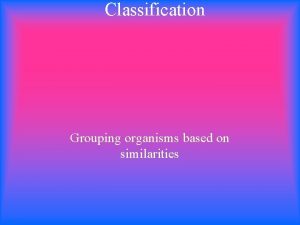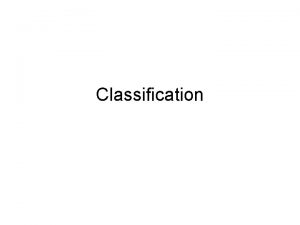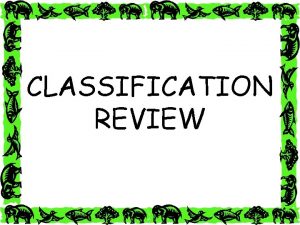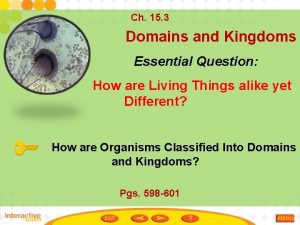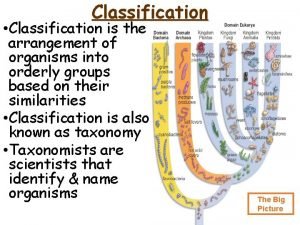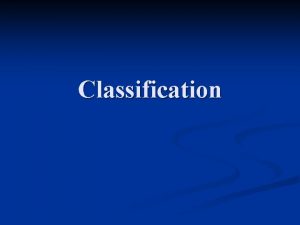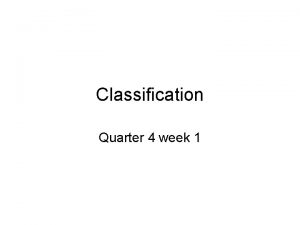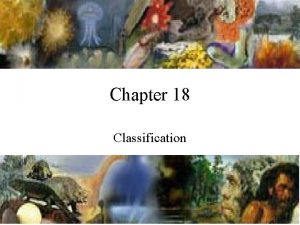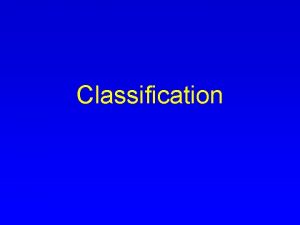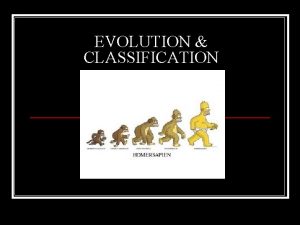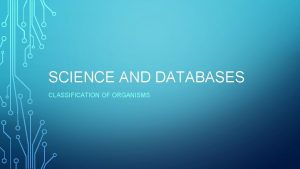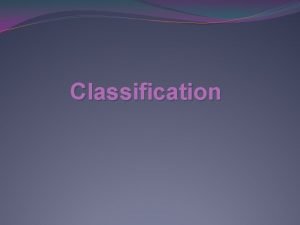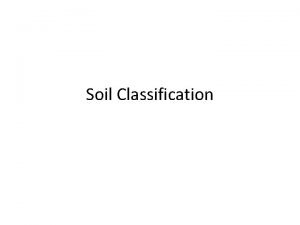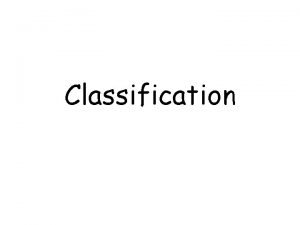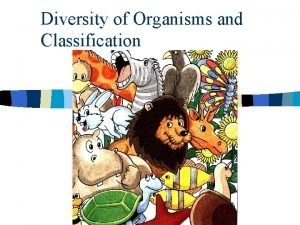Classification Classification the science of grouping organisms into














- Slides: 14

Classification • Classification: the science of grouping organisms into taxonomic groups • Based on similarities among organisms

Classification • Biodiversity: diversity among living species in a particular area • Scientists use classification to organize and classify the millions of organisms that make up Earth’s biodiversity

Classification • Taxonomy: classifying and scientifically naming organisms • Individual groups: taxa (taxon: singular)

History of Classification • Aristotle • Divided all organisms into 2 main groups • Plants and animals • They were further subdivided into water, land air • Linnaeus’ system of classification: expanded on classification to develop the modern system • Established the hierarchy on the next slide

Classification Hierarchy • Kingdom: groups of different phyla • Phylum: groups of different classes • Class: groups of different orders • Order: group of different families • Family: groups of different genera • Genus: groups of different species • Species: most specific category • Can breed and produce fertile offspring Kingd om Phylum Class Order Family Genus Species

Linnaeus’ Classification System • The modern system also includes domains: • Domain: largest taxonomic group; encompasses all life • 3 domains: archaea, bacteria, eukarya • Also developed binomial nomenclature • 2 word naming system to group organisms • Still based on characteristics • 2 part scientific name; using genus first, followed by species • Italicized (or underlined when written) • Examples: Homo sapies (humans); Quercus alba (white oak); Eublepharus marularius (leopard gecko); Quercus palustris (pin oak) • What do you notice about the white oak and pin oak? • Share the same genus (most closely related)

Binomial Nomenclature Practice • Pick up a half-sheet from the front table. • Using the word bank and key, determine the scientific name of the organisms listed.

Dichotomous Key: multi-step tool used to identify a species

Classification • Modern taxonomy describes 3 domains: • Archaea: all are prokaryotes • Bacteria: all are prokaryotes • Eukarya: all are eukaryotes • Most diverse domain and includes most of the organisms you are familiar with • Protists, Fungi, Plants and Animals are all classified within the domain of Eukarya

Archaea • Includes only the kingdom, Archebacteria: • Single-celled, prokaryotic bacteria • Anaerobic: can’t tolerate oxygen • Producers, consumers or decomposers and live in extreme conditions

Bacteria • Includes only the kingdom, Eubacteria: • Single-celled, prokaryotic bacteria • “True” bacteria that are autotrophic, heterotrophic or chemotrophic • Eubacteria are found everywhere, even thriving on your skin • Most are harmless, but some may cause harmful infections

Eukarya • Includes the kingdoms: Protista, Fungi, Plantae, and Animalia • Plantae: photosynthetic organisms with cell walls and chloroplasts • Animalia: complex heterotrophic organisms • Protists: eukaryotes that do not fit easily into any other group • Classified as plant-like, animal-like or fungus-like

Protists • Plant-like protists: classified by method of nutrition (photosynthesis) • Examples: algae (Euglenas, golden algae, diatoms, dinoflagellates) • Animal-like protists: classified by method of movement • Examples: protozoa (ciliates, flagellates, amoeboids, sprozoa) • Fungus-like protists: classified by method of nutrition (break down) • Examples: slime molds (water molds, downy mildews, white rust)

Fungi • Heterotrophic organisms that feed on dead matter • Decomposers: break down food • • • Contain cell walls but no chloroplasts Reproduce sexually (spores) and asexually (budding) Some fungi may cause infections or respiratory diseases Lichen: symbiotic relationship between fungi and algae Mycorrhizae: symbiotic relationship between fungi and vascular plants (both benefit)
 This is the study of grouping and naming organisms
This is the study of grouping and naming organisms The grouping of organisms based on similarities.
The grouping of organisms based on similarities. Process of grouping things based on their similarities
Process of grouping things based on their similarities This is the study of grouping and naming organisms
This is the study of grouping and naming organisms Member of the same species
Member of the same species Uni and multicellular organisms
Uni and multicellular organisms Grouping task into department job description
Grouping task into department job description A characteristic or quality describing an entity is called
A characteristic or quality describing an entity is called Grouping jobs into manageable units
Grouping jobs into manageable units Favorite subject science
Favorite subject science What is the science of grouping or organizing things
What is the science of grouping or organizing things How are organisms classified into domains and kingdoms
How are organisms classified into domains and kingdoms Biology organism classification
Biology organism classification 6 kingdoms of taxonomy
6 kingdoms of taxonomy Arrangement of organisms
Arrangement of organisms
